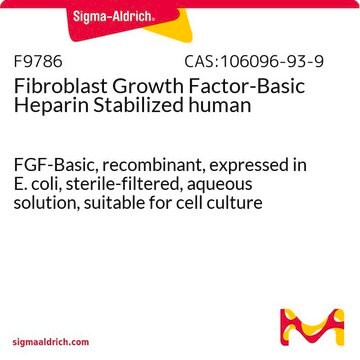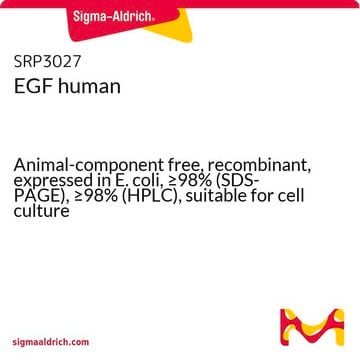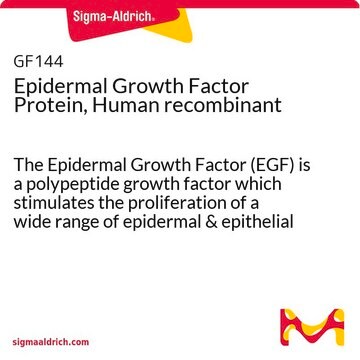GF003AF
Fibroblast Growth Factor basic, human
Animal free, >95% (SDS-PAGE), recombinant, expressed in E. coli, suitable for cell culture
Synonym(s):
FGF-2, bFGF, basic-FGF, Heparin-Binding Growth Factor 2, Prostatropin
About This Item
Recommended Products
product name
Fibroblast Growth Factor basic, human recombinant, animal-free, The Fibroblast Growth Factor-basic (or bFGF protein) is a heparin binding growth factor which stimulates the proliferation of a wide variety of cells including mesenchymal, neuroectodermal & endothelial cells.
biological source
human
Quality Level
Assay
>95% (SDS-PAGE)
manufacturer/tradename
Chemicon®
technique(s)
cell culture | stem cell: suitable
impurities
<0.1 EU/μg Endotoxin (of bFGF)
input
sample type epithelial cells
sample type mesenchymal stem cell(s)
sample type: human embryonic stem cell(s)
sample type neural stem cell(s)
sample type pancreatic stem cell(s)
NCBI accession no.
UniProt accession no.
General description
Application
Physical form
Storage and Stability
General applications:
After a quick spin, reconstitute in 0.1M phosphate buffer, pH 6.8, to a concentration of 0.1-1.0 mg/mL. Reconstituted bFGF should be stored in working aliquots at -20°C for up to six months. Multiple freeze/thaw cycles will result in significant loss of activity.
For Human ES cell culture:
After a quick spin, reconstitute to 10 μg/mL in a filtered solution of 0.5% BSA, 1 mM DTT, and 10% glycerol in Dulbecco′s PBS. Aliquot and store at -20°C for up to six months. This solution can then thawed and diluted to 4 ng/mL for the culture of human ES cells with a feeder layer, or to 8 ng/mL to supplement mouse embryonic fibroblast-conditioned medium (for feeder-free human ES cell culture).
Analysis Note
Legal Information
Disclaimer
Storage Class Code
11 - Combustible Solids
WGK
WGK 3
Certificates of Analysis (COA)
Search for Certificates of Analysis (COA) by entering the products Lot/Batch Number. Lot and Batch Numbers can be found on a product’s label following the words ‘Lot’ or ‘Batch’.
Already Own This Product?
Find documentation for the products that you have recently purchased in the Document Library.
Customers Also Viewed
Articles
Fibroblast growth factors in cell culture and various growth factors for your research
Protocols
Cultivate ReNcell® human neural stem cells in 3D hydrogels for high-throughput screening using the TrueGel3D® HTS Hydrogel Plate with this protocol.
TrueGel3D® Hydrogel Plate protocol guides high-throughput culture of human adipose MSCs for screening applications.
Our team of scientists has experience in all areas of research including Life Science, Material Science, Chemical Synthesis, Chromatography, Analytical and many others.
Contact Technical Service













